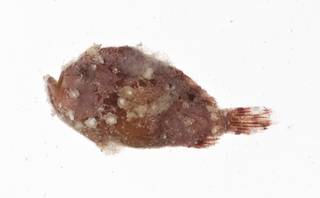
| Introduction | | Search taxa | | Taxon tree | | Taxon match | | Checklist | | Literature | | Stats | | Photogallery | | OBIS Vocab | | Log in |
CaRMS taxon detailsAntennariidae Jarocki, 1822
Antennariinae · unaccepted (Not useful anymore since...)
Not useful anymore since Histiophryninae was uplifted to family rank
marine, brackish,
Not documented
Distribution Distribution: all tropical seas except the Mediterranean. Body short, spherical, and laterally compressed with lateral...
Distribution Distribution: all tropical seas except the Mediterranean. Body short, spherical, and laterally compressed with lateral eyes; mouth large with 2-4 more or less irregular rows of small, villiform teeth on upper and lower jaws; tube-like gill opening under pectoral base, used for jet-propelling. Three dorsal spines on head, the anteriormost (illicium) free and modified as a lure, usually with a distinct fleshy bait (esca). Cutaneous filaments or appendages nearly always present; color and color pattern highly variable from white, yellow, red to dark brown and black. Juveniles and adults benthic in 0-300 m, with the single exception of Histrio, which pelagic in floating sargassum weed. Voracious carnivores feeding on smaller fishes or crustaceans attracted by wriggling the bait. To 33 SL in Antennarius avalonis. [details]
Froese, R. and D. Pauly. Editors. (2024). FishBase. Antennariidae Jarocki, 1822. Accessed through: Nozères, C., Kennedy, M.K. (Eds.) (2024) Canadian Register of Marine Species at: https://www.marinespecies.org/carms/aphia.php?p=taxdetails&id=125484 on 2024-04-24
Nozères, C., Kennedy, M.K. (Eds.) (2024). Canadian Register of Marine Species. Antennariidae Jarocki, 1822. Accessed at: https://marinespecies.org/carms/aphia.php?p=taxdetails&id=125484 on 2024-04-24
Date action by
taxonomy source
Van Der Laan, R.; Eschmeyer, W. N.; Fricke, R. (2014). Family-group names of Recent fishes. <em>Zootaxa.</em> 3882(1): 1-230., available online at https://doi.org/10.11646/zootaxa.3882.1.1 [details] Available for editors
context source (PeRMS) Chirichigno, N.; Cornejo, M. (2001). Catálogo comentado de los peces marinos del Perú. <em>2ª ed. Instituto del Mar de Perú. Publicación Especial. Callao.</em> 314 p. [details] basis of record van der Land, J.; Costello, M.J.; Zavodnik, D.; Santos, R.S.; Porteiro, F.M.; Bailly, N.; Eschmeyer, W.N.; Froese, R. (2001). Pisces, <B><I>in</I></B>: Costello, M.J. <i>et al.</i> (Ed.) (2001). <i>European register of marine species: a check-list of the marine species in Europe and a bibliography of guides to their identification. Collection Patrimoines Naturels,</i> 50: pp. 357-374 (look up in IMIS) [details] additional source Fricke, R., Eschmeyer, W. N. & Van der Laan, R. (eds). (2024). ECoF. Eschmeyer's Catalog of Fishes: Genera, Species, References. <em>California Academy of Sciences. San Francisco.</em> Electronic version accessed dd mmm 2024., available online at http://researcharchive.calacademy.org/research/Ichthyology/catalog/fishcatmain.asp [details]  Present Present  Inaccurate Inaccurate  Introduced: alien Introduced: alien  Containing type locality Containing type locality
From other sources
Distribution Distribution: all tropical seas except the Mediterranean. Body short, spherical, and laterally compressed with lateral eyes; mouth large with 2-4 more or less irregular rows of small, villiform teeth on upper and lower jaws; tube-like gill opening under pectoral base, used for jet-propelling. Three dorsal spines on head, the anteriormost (illicium) free and modified as a lure, usually with a distinct fleshy bait (esca). Cutaneous filaments or appendages nearly always present; color and color pattern highly variable from white, yellow, red to dark brown and black. Juveniles and adults benthic in 0-300 m, with the single exception of Histrio, which pelagic in floating sargassum weed. Voracious carnivores feeding on smaller fishes or crustaceans attracted by wriggling the bait. To 33 SL in Antennarius avalonis. [details]
|
